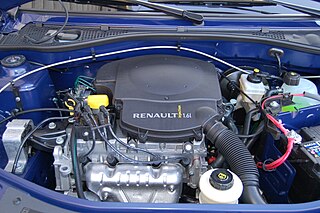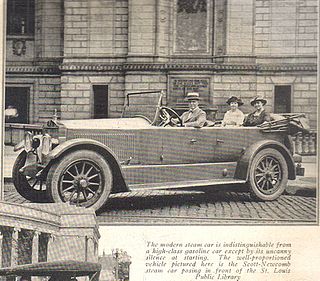The Locomobile Company of America was a pioneering American automobile manufacturer founded in 1899, and known for its dedication to precision in the pre-assembly-line era. It was one of the earliest car manufacturers in the advent of the automobile age. For the first two years after its founding, the company was located in Watertown, Massachusetts. Production was transferred to Bridgeport, Connecticut, in 1900, where it remained until the company's demise in 1929. The company manufactured affordable, small steam cars until 1903, when production switched entirely to internal combustion-powered luxury automobiles. Locomobile was taken over in 1922 by Durant Motors and eventually went out of business in 1929. All cars ever produced by the original company were always sold under the brand name Locomobile.

An antique car is an automobile that is an antique. Narrower definitions vary based on how old a car must be to qualify. The Antique Automobile Club of America defines an antique car as over 25 years of age. However, the legal definitions for the purpose of antique vehicle registration vary widely. The antique car era includes the Veteran era, the Brass era, and the Vintage era, which range from the beginning of the automobile up to the 1930s. Later cars are often described as classic cars. In original or originally restored condition antiques are very valuable and are usually either protected and stored or exhibited in car shows but are very rarely driven.

The Brass Era is an American term for the early period of automotive manufacturing, named for the prominent brass fittings used during this time for such things as lights and radiators. It is generally considered to encompass 1896 through 1915, a time when these vehicles were often referred to as horseless carriages.

De Dion-Bouton was a French automobile manufacturer and railcar manufacturer operating from 1883 to 1953. The company was founded by the Marquis Jules-Albert de Dion, Georges Bouton, and Bouton's brother-in-law Charles Trépardoux.

The early history of the automobile can be divided into a number of eras, based on the prevalent means of propulsion. Later periods were defined by trends in exterior styling, size, and utility preferences.
The Empire Steamer was a steam-driven car designed by William H. Terwilliger of the Empire Auto Company of Amsterdam, New York. Several experimental models were made from 1898 but production only started in 1904. The car had a two-cylinder engine with boiler mounted centrally. the cars were advertised at $2000.

As of 2013, there were a wide variety of propulsion systems available or potentially available for automobiles and other vehicles. Options included internal combustion engines fueled by petrol, diesel, propane, or natural gas; hybrid vehicles, plug-in hybrids, fuel cell vehicles fueled by hydrogen and all electric cars. Fueled vehicles seemed to have the short term advantage due to the limited range and high cost of batteries. Some options required construction of a network of fueling or charging stations. With no compelling advantage for any particular option car makers pursued parallel development tracks using a variety of options. Reducing the weight of vehicles was one strategy being employed.
The Skene was an American automobile manufactured from 1900 to 1901. A twin-cylinder 5 hp steam car, it was built in Lewiston, Maine. Despite its makers claims of "many points of superiority", the Skene seems to have been rather unremarkable.
The Binney & Burnham was an American automobile built in Boston from 1901 to 1902 by James L. Binney and John Appleton Burnham. It was a twin-cylinder steam car.

The Standard Steam Car was an American steam car manufactured by the Standard Engineering Company of St Louis, Missouri from 1920 until 1921. Also known as the Scott-Newcomb, it featured a front condenser that resembled a Rolls-Royce-shaped radiator and was similar in appearance to the Roamer. The car had a twin-cylinder horizontal steam engine and used kerosene for fuel. The boiler pressure was stated as 600psi but it was claimed to be able to raise a full head of steam within a minute. One touring car is known to have been built; the company may have produced as many as five vehicles before folding.
The Empire was an American automobile manufactured from 1901 until 1902. A product of Sterling, Illinois, it featured a vee-twin Steam engine geared to its right-hand rear wheel. It had a rectangular, transverse mounted boiler with horizontal tubes across the chassis. Coachwork was of the motor buggy style.

A car is a wheeled motor vehicle used for transportation. Most definitions of car say they run primarily on roads, seat one to eight people, have four tires, and mainly transport people rather than goods.

The history of steam road vehicles comprises the development of vehicles powered by a steam engine for use on land and independent of rails, whether for conventional road use, such as the steam car and steam waggon, or for agricultural or heavy haulage work, such as the traction engine.

The Ross was a brass era steam automobile built in Newtonville, Massachusetts from 1906 to 1909.

The Jackson Automobile Company was an American Brass Era automobile manufacturer located in and named for Jackson, Michigan. The company produced the Jackson from 1903 to 1923, as well as the 1903 Jaxon steam car and the 1904 Orlo.
William L. Grout (1833–1908) was an U. S. industrialist and pioneer manufacturer of sewing machines and automobiles.

Stearns Steam Carriage Company (1901–1904) was a manufacturer of steam automobiles in Syracuse, New York, founded by Edward C. Stearns, an industrialist. Stearns built his first automobile in 1899, an electric which sold so few models through 1900 that the firm changed to steam power in 1901 when the company was incorporated. The company was also known as the Stearns Automobile Company.
This is a chronological index for the start year for motor vehicle brands. For manufacturers that went on to produce many models, it represents the start date of the whole brand; for the others, it usually represents the date of appearance of the main model that was produced.













